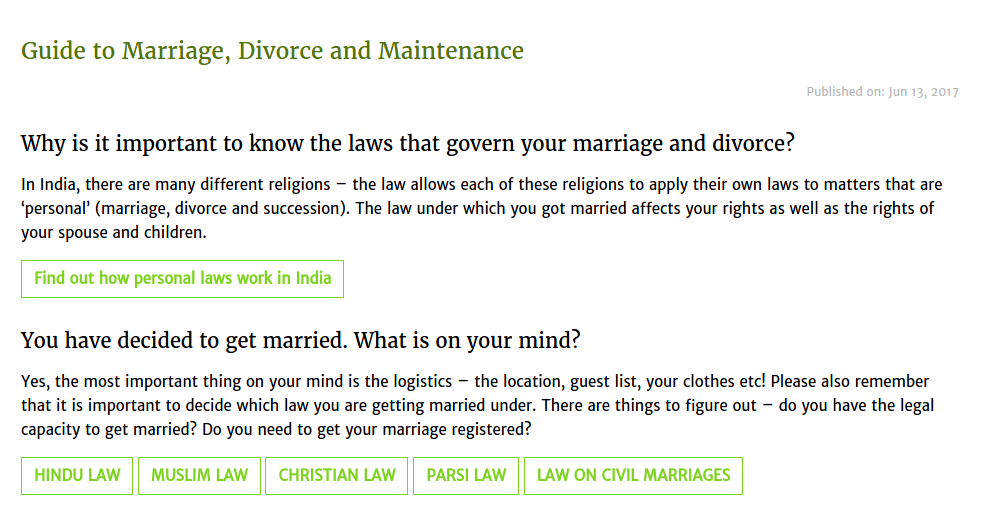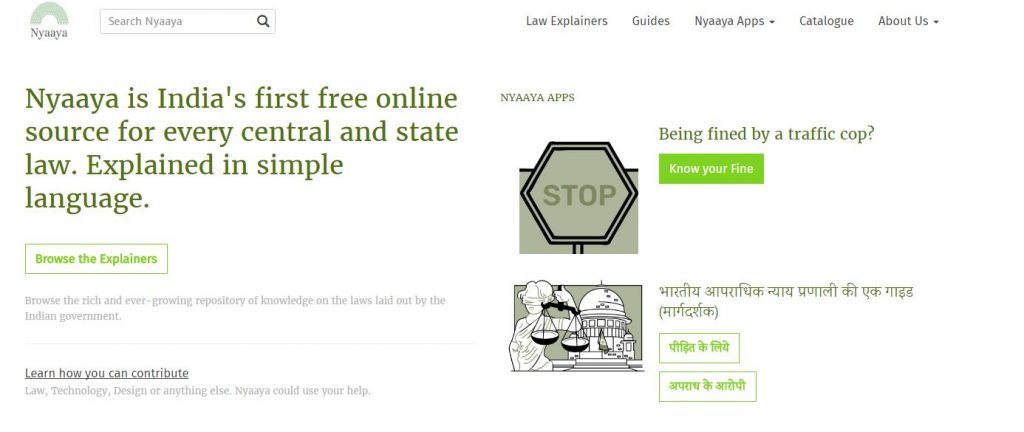Opening up India’s laws – the journey of Nyaaya.in, a non-profit legal tech organization in India
India seems to fare reasonably well on ‘open data’ and ‘open government’ indicators. However its abysmal record with respect to enforcement of rights and its civil and criminal justice systems points towards an inability to use this information meaningfully and for the purpose of actual legal empowerment. Nyaaya, a new legal tech organization in India, is attempting to make an intervention by applying standard legislative markup tools for the first time in the country and by developing plain language explainers and guides.
Surveys conducted in other jurisdictions point towards a direct relationship between people’s awareness of the law and legal services and problem resolution strategies. For example, consider the case of a senior citizen who has been abandoned by her children and needs financial help in supporting herself. There is more than one law she can look at to address her problem in India – provisions in the criminal procedure code, religious laws of certain communities or a special law on the maintenance of senior citizens. Even to take the first step of approaching a lawyer, she needs to have already known that she has a right to maintenance under various laws or be able to easily find this information. Assuming she’s taken this first step, the senior citizen is very likely to be misinformed or not be presented with her full range of options given the poor quality of legal representation one is very likely to find in most Indian courts. Access to accurate and easy-to-comprehend legal information is a critical enabler in the realization of various constitutional and legal rights.
The Global Open Data Index 2016, published by Open Knowledge International, describes India’s national laws as 45% ‘open’. Yet, as we discuss in this post, the way in which these laws have been made available do not allow for citizens to extract even simple legal information easily.
The central government in India in its effort to publish laws digitally put together a portal known as IndiaCode in the mid 1990s. The design and search functions of this portal were rudimentary – the laws are published without more recent amendments and in completely unreadable formats. For example, the image below indicates how the primary and most important criminal law of the country (i.e, the Indian Penal Code, 1860) continues to be published on the portal.

India has a quasi-federal structure – laws are issued by the central government and its various states. At the state level, there are only a few state governments or courts which have actually made complete sets of their laws available online. Even then, most states continue to publish laws in formats which are not machine readable. For example, the eastern state of Odisha publishes its laws in this format:

A third very important body of statutory law in the country, is subordinate law in the form of rules, regulations, circulars, notifications and guidelines. These are again published in an ad-hoc manner by both central and state governments. While the Gazette published by the central government has published more recent rules and regulations, these again take the form of PDFs and very often scanned PDFs.
These different resources suffer from numerous problems including the fact that they are not searchable, updated to reflect amendments, hyperlinked or published in user-friendly formats. Consider one such problem – the lack of updated or consolidated laws make the laws unreliable for use by laypersons who are generally unaware of the fact that they must look at a law with all amendments to understand the position of law as it stands today. The laws passed by the Central Government can be considered as some of the most important laws regulating a person’s life in India – even these were unavailable in a consolidated version until 2016. A decision by the Chief Information Commission (authority set up under the freedom of information law in India) in 2015 recognized the responsibility of the government in making consolidated versions of the law available. Following this decision, the Central Government has, as of date, made most laws between 1947 and 2016 available on IndiaCode.
However, given that the government has approached this exercise without giving much thought to best practices and without actually being interested in ‘opening’ laws, in the same way that it has approached opening other forms of data, this manually, at a slow pace with the output taking the form of PDFs. Recognizing that this approach is not sustainable in the long run, the Delhi High Court has very recently directed the government to consider developing technical standards in the drafting and publication of laws.
The unavailability of laws passed by different types of governments, the inaccessible format of the available documents and the text of the law itself has essentially allowed the understanding of laws and legal information to remain the privilege of a few (lawyers and judges). Locking up of laws in this manner contributes significantly to the alienation of the justice system and public services from the public.
To understand how we could use laws and legal information in bridging this gap, a small team of lawyers and technologists got together with the support of a visionary philanthropist in 2016 to form Nyaaya.in. It was started with the simple goal of being a single resource for national and state laws along with plain language explainers. Nyaaya is a digital resource that is trying to bridge the gap between the availability of laws and legal literacy by making laws machine readable and by providing simple legal information to answer simple legal queries as well as complex legal processes.
It aims to be a single resource where one can connect the dots between different types of laws so that it can be used fruitfully in understanding their rights under the law. Our constant endeavour is to use design principles to connect the dots between unstructured and disaggregate legal information in different forms such as Acts, Rules, Regulations and Notifications. While the linking of legal information is currently being done by an internal team, we are also building systems which will allow for external volunteers and contributors to make the connections and create content.
A key component in this integrated platform will be presentation and tagging of annotations to individual legal provisions. These annotations can help not only serve the purpose of an explainer or commentary for the section, but also help in understanding the interplay between the primary law with subordinate legislation and state amendments to federal laws (a unique form of statutory instrument in India).
To make legal information consumable and empowering, the information must also be machine readable. Making laws machine readable can monumentally improve the users’ search for accurate legal information to their queries. Going back to the example, technology that is able to identify maintenance provisions in the gamut of Indian laws will deliver faster and more accurate results for the senior citizen who is using the internet as her first source of information. Nyaaya uses Indigo a tool developed by a civic-tech organisation in South Africa, OpenUp in order to capture and manage laws in Akoma-Ntoso. Akoma-Ntoso is a popular XML schema for describing legislative documents. The laws marked up in Akoma-Ntoso which are published on Nyaaya are available on Github here.

The biggest challenge when it comes to making laws machine readable is parsing and extraction of laws. The long legacy of private publishing has continued to influence the presentation of laws being published online. Government bodies publish laws in the manner in which they are extracted – as scanned PDFs (which are highly unstructured data). Further, the traditional structure of marginal notes and footnotes (indicating amendments) make it difficult for machines to identify the components of a law correctly and also makes publishing of laws at different points of time (prior to and after an amendment) next to impossible.
India, being a country with 29 states and 7 union territories, there is an entire body of law which haven’t even been published digitally, let alone being published in machine-readable and open formats. As a country, open data enthusiasts in India have several things going their way – a government which is (at least superficially) enthusiastic about embracing technology, a robust freedom of information law and a growing open data movement. However, opening up of laws is only a very recent and new focus for a limited section of civil society and government.
While the initial inspiration behind this initiative was to make laws accessible to laypersons, our experience this last year has helped us realize how critical this is to access to justice and public services. The journey of having to re-imagine laws and legal information this last year has also helped us realize that the need of the hour is developing an India-specific legislative mark-up language. We’re smitten by the transformative potential that a combination of laws, design and technology offers and hope to use the next year to make giant leaps in the manner simple and useful legal information is delivered to the general public (including through regional languages!)
Nidisha Philip is an Indian lawyer working on using technology in the fields of public legal education and access to justice.









